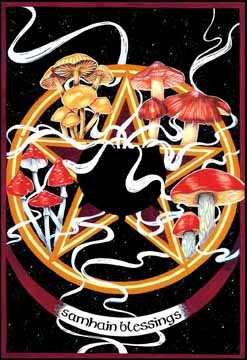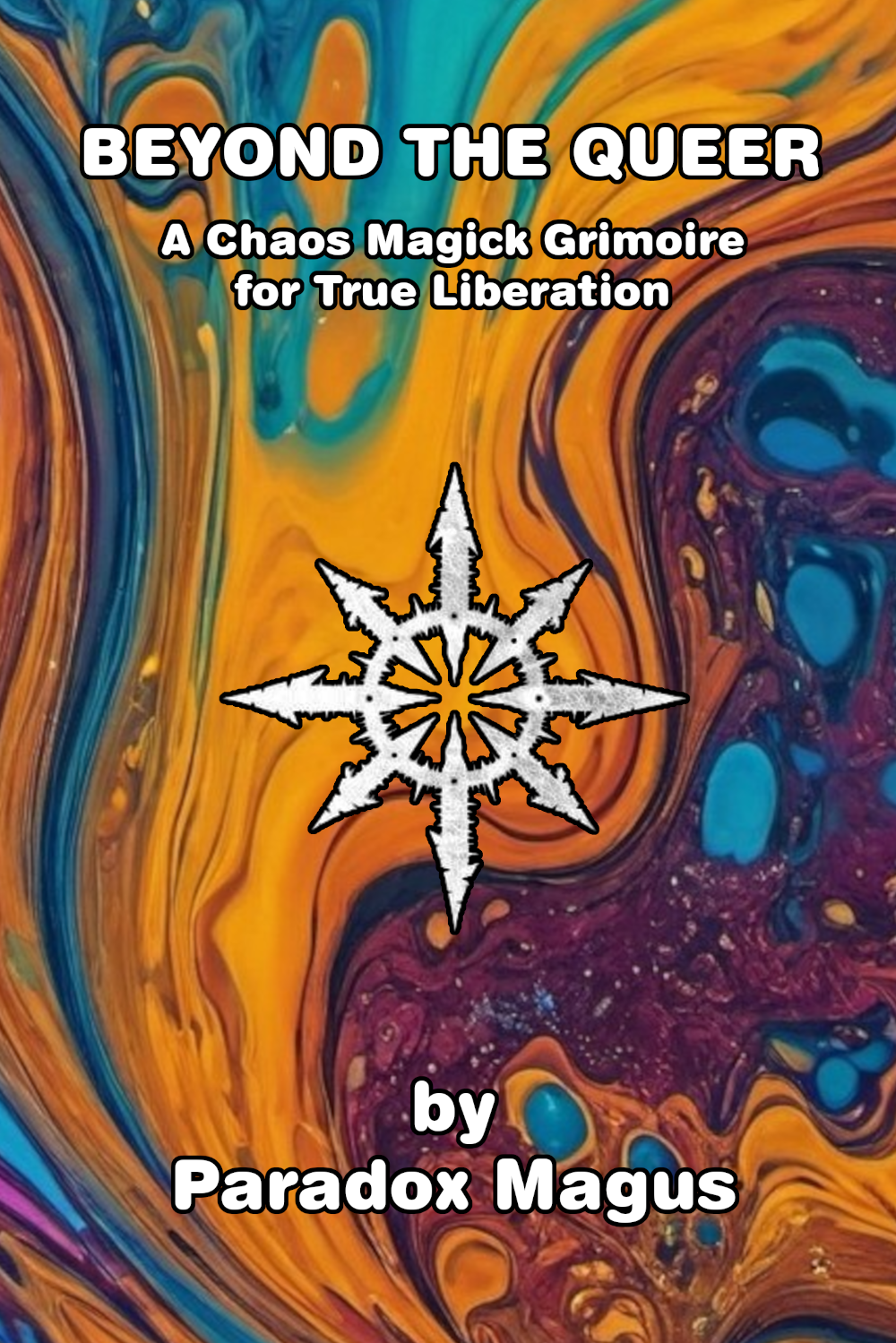
Samhain is one of the four Major Sabbaths of the magical wheel of the year and is celebrated in the month of Hekate, on the night from the 31st of October to the 1st of November. It is the dark counterpart of Beltane.
The pagan festival was consecrated to the dead, to the old year and to the end of a complete cycle of the Celtic wheel of life. For Celts and Anglo-Saxons it was the end of summer and the beginning of the new year. The ritual calendar began when the Sun was setting in the ecliptic system, a system used by ancient priest-astronomers to determine the seasons by the motion of the Sun. It is the midpoint between the Autumnal Equinox and the Winter Solstice.
It was a time of purification in which images representing the fears of the participants were burnt.
For neo-pagans the God dies at this time to be reborn at Yule.
The god was sometimes depicted with two faces, as two-faced Janus. One face looks to the past, watching those who have gone, and the other to the future, gazing at those who are yet to come. He dismisses and receives.
Those who died this year are especially remembered on this night.
The Celts lit bonfires in the mountains to ward off evil spirits. The last harvest was gathered and what was not harvested was left in the fields as an offering to the spirits.
During the night, people worshipped occult and mystical powers, witchcraft, dark feminine power...
It is an ideal moment to think about our condition as mortal beings or beings-for-death, in the words of Heidegger.
The Celts believed that on this night souls returned to their ancient homes. The lights on the pumpkins were used to guide the ancestors to their homes. They also put a white candle in the window and a little milk, and some people have a silent supper with a plate and a chair for each deceased person as an invitation. The veil between the two worlds is thinner on this night and therefore it is easier to establish contact with beings from the astral plane. Many magicians take advantage of this to hold ouija or spiritism sessions.
Christianity adapted this pagan festival into its All Hallows' Day or All Souls' Day.
In Celtic mythology the fairy folk also celebrate Samhain. On the eve of November fairies were allowed to take mortal husbands and all the caves were opened so that any mortal who dared could have a peek into their treasure-filled palaces.
In Ireland and Scotland there is a popular belief that the souls of the leprechauns appear on this night. In Celtic Ireland the Oidhche Shamhna, or November Eve, heralded the start of the great festival with games and races in honour of Tlachta, the mother goddess. This ancient deity gave rise to the Cailleach and Morrigana. The Cailleach presided over the festival together with Dagda, the founding god of Druidism. Together they represented the primordial forces responsible for birth and death.
As a ritual for this magical night we can make a symbolic journey to the underworld by taking a walk through a labyrinth... since the labyrinth is a metaphor for the journey of the dead and rebirth. It would be perfect to visit a stone labyrinth or one of those that can be found in gardens. Or draw one in the sand, or draw it on the ground with branches or ropes. This way we can stage our transformation. We can ask Hecate for advice and guidance.
It is a good time to get rid of everything that has not worked and start again.
We must look for protective vibrations to keep negativity at bay for the next twelve months.
The spirits of the dead wander until this day, when they may cross over to the other side to rest. We can try to contact the ancestors, mourn the dead and help them complete their journey.
The skull was the main symbol of this festival and was replaced by the typical pumpkins that we now see everywhere.
The sign of the cross is very important on this day because of its power against evil. Mirrors are also used to frighten souls, and transparent crystals, which are powerful protectors. The scorpion is also used because it is the sign of the month. The most representative talismans are mirrors and pictures of deceased relatives.
Divination is practised particularly with black mirrors or crystal balls.
It is a time to connect with the wisdom within. There is a Celtic legend that tells of the four grandmothers on Halloween who each have a treasure that they jealously guard: the cauldron of rebirth symbolising pleasure; the stone of destiny, representing power; the spear as a symbol of courage; and the sword representing knowledge.
The custom of going door to door for sweets comes from the English tradition of collecting food or money for the poor. In some parts of Europe, food is still handed out to the poor at cemetery gates.
In Scotland they dressed up and changed their roles at least once a year; men dressed up as women and women as men. In ancient times the Celts dressed in white to welcome the first day of winter.
The elders represent the old year and are therefore held in higher esteem on this day. The Goddess appears in her old woman/witch (Crone) guise. It is also a good time to honour the wisdom of witches by freeing them from the prejudices and attacks of other religions.
Gems: jet, obsidian, tourmaline and onyx.
Plants: broom, fern, sage and mandrake, oak leaves and holly.
Incense: rue, mandrake.
Gods: Anubis, Osiris, Selket, Hecate, Lilith, Innana, Ereshkigal, Holly King, Kali, the Sacred Death...
Colors: blood-red, orange and black, purple.
Food: pumpkin, baked apples, pomegranate, walnuts, chestnuts, warm cider.
Other relationships: Death in Mesopotamian culture was a state of purification leading to a new life. The goddess Inanna decided to descend to the underworld to confront her sister and opposing deity, Ereshkigal. In the fight Inanna dies. Enki creates some genderless creatures who trick Ereshkigal into giving them the corpse of the goddess to which they apply the "water of life". Inanna is resurrected, but has to find a replacement to take her place in the afterlife. When she returns to earth she finds that her husband Dumuzi has taken her place. Dumuzi reigns during autumn and winter, while Inanna reigns during spring and summer.
Osiris was the god of resurrection, symbol of fertility and regeneration of the Nile. He dies as a man but is resurrected as immortal thanks to the god Thoth. He is responsible for judging the dead in the Duat, where he is accompanied by 42 gods-judges who rule on what will happen to the deceased. In funerary texts the deceased pharaoh was identified with Osiris, king of the dead, just as he had been in life with his son Horus.


